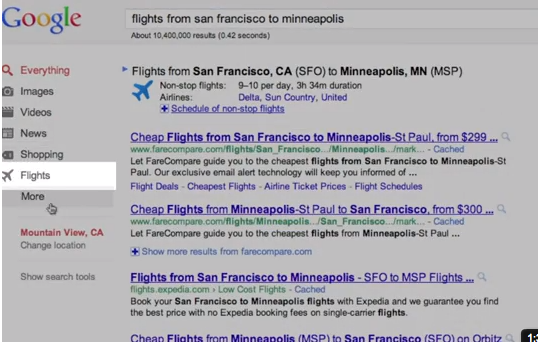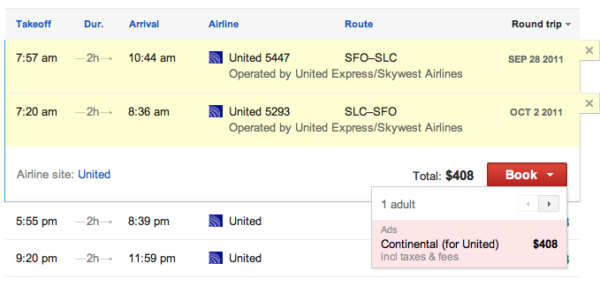Google Travel Search Takes Flight With First ITA Travel Product
Google has made what amounts to a promising downpayment on more ambitious travel search tools with its new Flight Search, debuting today. Launching initially for a select group of US cities Google users will have access to an expanded range of airline search options and a much more verticalized experience than has been available in […]
 Google has made what amounts to a promising downpayment on more ambitious travel search tools with its new Flight Search, debuting today. Launching initially for a select group of US cities Google users will have access to an expanded range of airline search options and a much more verticalized experience than has been available in the past on Google.
Google has made what amounts to a promising downpayment on more ambitious travel search tools with its new Flight Search, debuting today. Launching initially for a select group of US cities Google users will have access to an expanded range of airline search options and a much more verticalized experience than has been available in the past on Google.
This is the first product to emerge from Google’s controversial acquisition of travel software company ITA, which closed in April and included concessions and guarantees to existing ITA customers such as Kayak, Microsoft, Orbitz, Hotwire and TripAdvisor. The past five months have been spent on integration of the ITA team and technology in Boston.

This Flight Search beta product breaks no new ground for online travel but points the way toward something more ambitious for Google. The company hinted at that more ambitious product vision in the blog post that announced the acquisition in July 2010:
[W]e think there is room for more competition and greater innovation. Google has already come up with new ways to organize hard-to-find information like images, newspaper archives, scholarly papers, books and geographic data. Once we’ve completed our acquisition of ITA, we’ll work on creating new flight search tools that will make it easier for you to search for flights, compare flight options and prices and get you quickly to a site where you can buy your ticket.
Presented in a way that is similar to Google’s current recipe-search tools and UI, a query such as “flights from sf to nyc” will trigger the appearance of a “flights” filter in the left column. That in turn leads to a more “vertical” experience that enables users to search for flights in a variety of different ways.
Below is a screen showing the new flight results page. Fliters on the left allow for refinement of the search by airline, loyalty program, number of stops and so on (not unlike what already exists at many competing travel sites). Users can manipulate dates, flight duration and pricing. They can aslso search for available flights based on destination and budget, a la Travel Muse.
Once an outbound and return flight are selected — there are no one-way or multi-city capabilities right now — users are taken to an airline website to book. The content presented in Flight Search results is all organic. However, as the image below indicates, the booking link is or could be an ad. According to Google this is the only advertising in Flight Search.
Google said it’s still experimenting with the model. It’s not entirely clear what would happen if the selected airline were not an advertiser. Are only advertiser flights being included in the data presented? I assume not. However when most travel sites such as Kayak or Orbitz deliver a user to an airline or hotel site there’s lead-gen fee or bounty paid. And Google may have struck agreements with all the major carriers accordingly.
As the screens above indicate a map figures prominently in the UI. However Google isn’t using Street View or integrating hotel search or its local business database (including reviews) into the product. That’s the opportunity in one sense: to fully leverage Google’s database and existing products to create totally new travel planning tools and user experiences. This is the “promise” of the ITA acquisition.
However Google famously refuses to discuss future plans. Indeed, Google won’t say anything beyond the fact that Google Flight Search is a first step and that it will improve over time. ITA’s “matrix search” may hold some clues to the future of Google Flight and Travel search products:
- Geo Search – search by airport code, city, or nearby airport selector
- Event Finder – plan your trip with a listing of events and things to do
- Interactive Calendar – explore date ranges and find the lowest fares
- Real-time Filters – focus on flights that suit your preferences
- Color-coded Time Bars – compare flights at a glance
Along those lines, one can easily imagine many creative and well integrated user experiences that take advantage of Google’s existing assets. Bing Visual Search for Travel is an example of a creative use of search, content and images for travel planning.
Right now Google Flight Search is a useful, if limited, tool. But absent some of the novel and creative innovations I allude to above, it doesn’t really put pressure on any of the established travel search brands or OTAs. Over time, that could change of course.
[youtube]https://www.youtube.com/watch?v=OC2bUYVkjrY[/youtube]
Contributing authors are invited to create content for Search Engine Land and are chosen for their expertise and contribution to the search community. Our contributors work under the oversight of the editorial staff and contributions are checked for quality and relevance to our readers. The opinions they express are their own.
Related stories


